Looking to generate more portable storage container leads? You’ve come to the right place!
If you’re in the portable storage container industry, you know very well that the biggest challenge isn’t delivering a quality container—it’s getting the right people to find you in the first place. Portable storage container leads can feel hard to come by, especially when demand is up and the competition is stiff. Don’t even get us started on seasonality or economic shifts—you know how tough it can get. But that’s why we’re here to help!
With the right strategies, getting consistent, high-quality portable storage container leads is not only possible, it’s scalable. Let’s talk about how to do it.
Related: How to Sell Shipping Containers
Who Buys Portable Storage Containers?
Before we dig into how to generate more leads, it helps to know who your ideal customer actually is. Different buyers have different priorities, and knowing who you’re targeting can help shape everything from your messaging to your outreach.
Usually, these buyers fall into specific industries that rely on portable storage containers for seasonal, short-term, or long-term needs. Below are some of the top sectors to focus on—plus the best times of year to go after them.
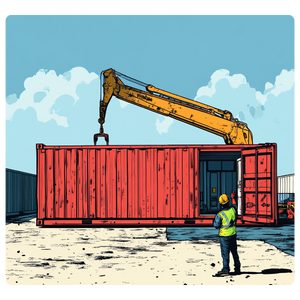
Construction Companies
The construction industry is one of the most reliable industries for container demand. Contractors and job site managers need secure, on-site storage for tools, equipment, and materials—especially on larger or long-term builds. They typically value speed, convenience, and flexibility in rental terms.
- Best Months to Target: March – October (peak construction season)
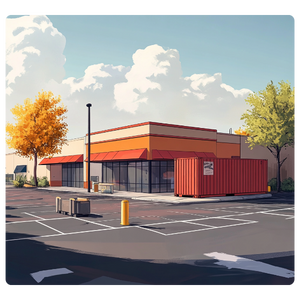
Retail Stores
Retailers often rent portable storage containers to manage overflow inventory during high-traffic seasons like the holidays or back-to-school rush. They’re looking for flexible rental terms, clean units, and reliable delivery.
But it doesn’t stop there—some retailers and restaurants also repurpose containers as temporary storefronts, takeout stations, mobile kitchens, or pop-up shops. It’s a creative way to keep business running during renovations, test new markets, or operate in areas with limited space.
- Best Months to Target: July – December (especially August, November, and early December)
Related: Planning Tips for Suppliers of Retail Storage Containers

Schools & Universities
Educational institutions rely on storage containers for a variety of needs. While some use them for storing desks, supplies, or athletic equipment during summer break or renovations, many also convert containers into temporary classrooms, offices, or portable testing centers. This makes containers a flexible, budget-friendly solution when permanent space isn’t available or construction is ongoing.
- Best Months to Target: May – August (summer break and prep season)

Manufacturing Plants
Manufacturers use containers to hold raw materials, tools, or extra products. Some need long-term rentals for ongoing storage, while others may buy in bulk. These clients tend to appreciate reliability, capacity, and long-term options.
- Best Months to Target: January – June (preparation for summer demand or seasonal production spikes)
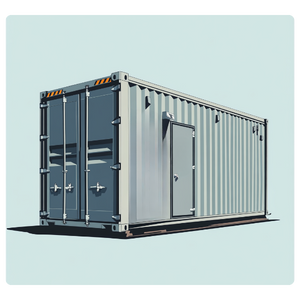
Government Agencies
Municipal and federal agencies often need portable storage for public works projects, disaster response, or infrastructure upgrades. These contracts may require paperwork or vendor approval, but can result in long-term or recurring business.
- Best Months to Target: September – March (fiscal year-end spending and new budget cycles)
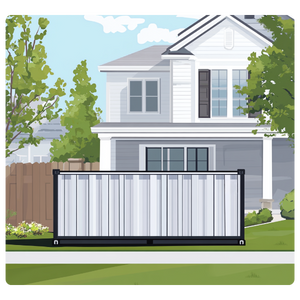
Homeowners and Movers
While not a traditional industry, residential customers make up a solid portion of seasonal container demand. Whether it’s for a renovation, a big move, or downsizing, they’re typically looking for simple, fast, and affordable solutions.
- Best Months to Target: April – August (spring cleaning, moving season, and home renovations)
How Do Most People Search for Storage Containers?
Once you know your audience, it’s time to think about where and how they’re looking for you. Spoiler: if you’re not showing up where people are searching, you’re missing out on easy wins.
Here’s how most people find portable storage container suppliers:
Google Search
No surprise here—Google is the #1 way buyers find storage containers. Whether they search “portable storage containers near me” or “20ft container for rent in [city],” having a strong local SEO presence is key.
Online Marketplaces
Many buyers head straight to lead generation platforms or comparison sites to get multiple quotes at once. These marketplaces help buyers save time—and if you’re on them, you can land leads without doing all the legwork yourself.
Referrals and Word of Mouth
This still goes a long way, especially in industries like construction. If you provide great service, customers will talk—and that can lead to a steady stream of referrals.
Social Media or Online Forums
Some buyers post in local Facebook groups or contractor forums asking for recommendations. While this isn’t the first place they look, having some kind of social presence helps build trust when they do their research.
Directory Listings
Sites like Yelp and even Google Business Profiles matter. Many residential or small-business customers use these to check reviews and compare options locally.
The bottom line? You need to be visible across multiple channels—especially where high-intent buyers are looking.
5 Effective Strategies to Get More Portable Storage Container Leads
So, how do you get in front of the right buyers at the right time? Here are five tried-and-true strategies that can help you attract more portable storage container leads and close more deals.
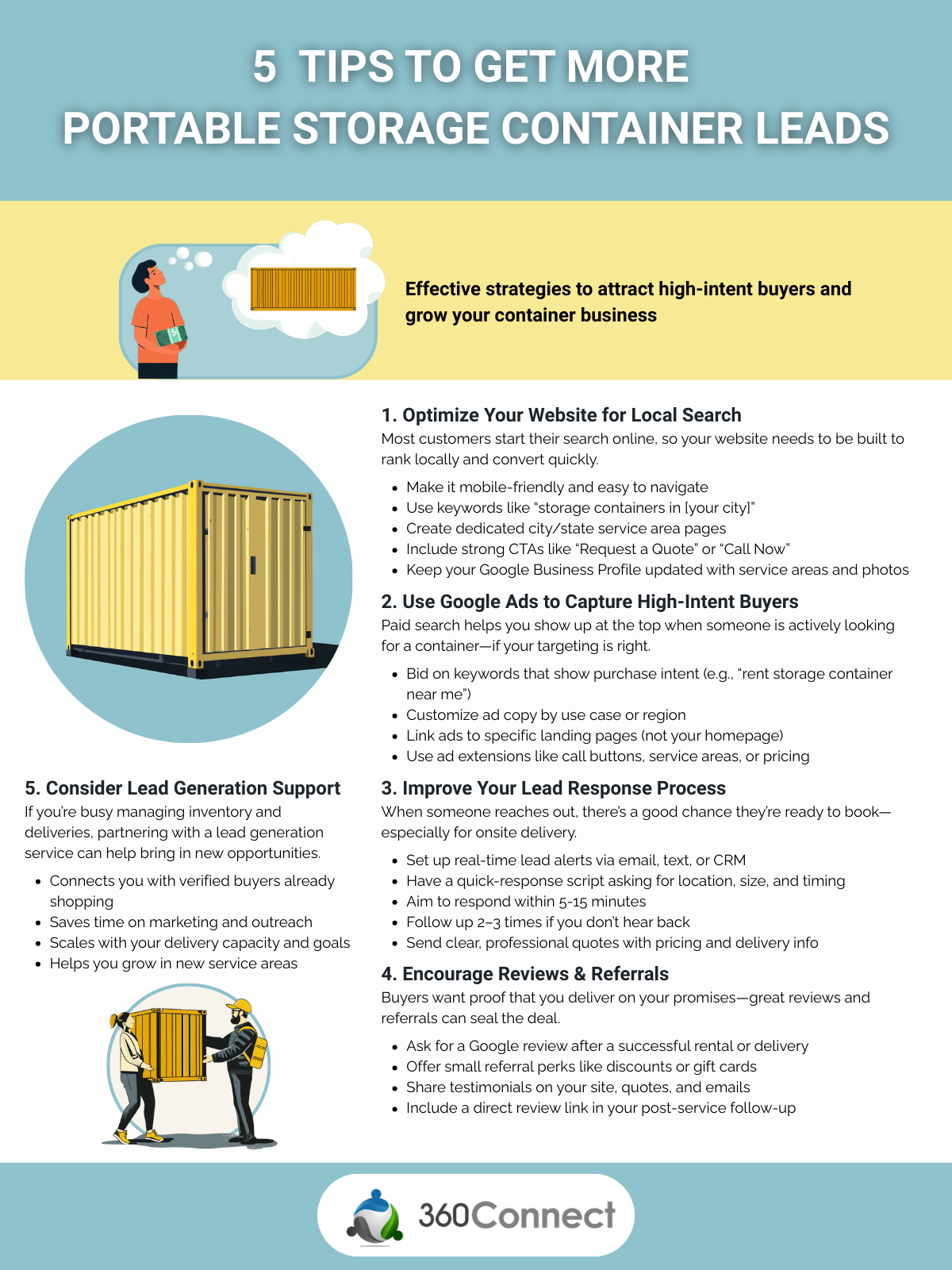
1. Optimize Your Website for Local Search
If your website isn’t working as a lead magnet, you’re leaving money on the table—plain and simple. Most buyers today start their search online, and if they can’t find your business (or your website doesn’t build trust), they’ll move on to a competitor. Even if you offer the best service in town, you won’t get far if no one can find you. That’s where local SEO comes in.
Start with the basics:
- Make sure your website is mobile-friendly and easy to navigate. A clunky site loses leads fast.
- Use keywords that reflect how your buyers search, like “portable storage containers in [your city]” or “jobsite container rental in [state]” to increase your chances of ranking locally.
- Add city or state-level service area pages that give Google (and your buyers) clear signals about where you operate.
- If you’re a nationwide provider: Don’t skip city/state pages—you can still rank locally even as a national brand. Focus on your top-performing markets and create high-quality content for each location.
- If you’re a local provider: Get specific! Optimize for your primary city and surrounding areas, and include local testimonials or service images when possible.
- Add a clear call-to-action (CTA) on every page: “Request a Quote,” “Call Now,” or “Get Pricing” should be easy to find and click.
- Claim and optimize your Google Business Profile with updated service areas, phone numbers, business hours, and photos of your containers.
Don’t underestimate how powerful local visibility can be. A well-optimized website helps you show up when buyers are searching—and more importantly, makes it easy for them to choose you. Even small tweaks can turn your website from a digital brochure into a 24/7 lead machine.
2. Use Google Ads to Capture High-Intent Buyers
When someone searches for a portable storage container, you want your business to show up at the top—and Google Ads is one of the best ways to make that happen. It puts you in front of people who are actively looking, but to make it worth your budget, you need to be smart about how you target.
Start with intent-based keywords:
- “20 ft storage container rental [city]”
- “jobsite storage units”
- “buy portable storage container near me”
These phrases show that the buyer isn’t just browsing—they’re ready to take action. Make sure your ad copy speaks to what they care about: fast delivery, flexible rentals, or on-site storage. Then lead them to a landing page that matches the ad and includes a clear call-to-action.
- Local providers: Use geo-targeting and local keywords to show up only in areas you serve.
- National providers: Still use regional or city pages in your targeting—you can rank locally at scale.
A focused Google Ads strategy keeps you in front of real buyers—and helps turn clicks into qualified leads. Just ensure you’re sending them to a page that makes it easy to convert.
3. Improve Your Lead Response Process
In the portable storage industry, timing is everything. When a lead reaches out, they’re often looking for a fast, convenient solution—especially for onsite storage needs. In fact, onsite storage accounts for approximately 72.38% of the U.S. portable storage container rental market, which means most buyers want containers delivered directly to their location without delays.
That’s why your lead response process needs to be sharp. If you’re not the first to reply, chances are they’ve already moved on to someone else who was.
Here’s how to tighten your lead response process:
- Set up real-time alerts (email, text, CRM) when a new inquiry comes in so nothing slips through the cracks.
- Have a standard response template ready for quick replies. Include basic questions like delivery location, container size, rental duration, and timeline.
- Follow up quickly. Ideally within 5 minutes. In fact, responding to leads within five minutes or less increases the likelihood that the opportunity will be converted 100 times. If that’s not possible, make it within the hour—same day at the very least.
- Don’t stop after one attempt. If you don’t get a reply, follow up again the next day. Many deals are won on the second or third contact.
- Send clear, professional quotes that outline pricing, delivery fees, rental terms, and what to expect.
In this industry, responsiveness builds trust. A prompt, helpful response shows you’re dependable—and that goes a long way when buyers need fast, hassle-free solutions.
4. Encourage Reviews and Referrals
When buyers are choosing between suppliers, positive reviews can tip the scale. And in the portable storage world, referrals and word-of-mouth still carry serious weight—especially among contractors, builders, and local businesses.
How to build credibility and drive new portable storage container leads:
- Ask for a review after a successful rental or delivery. A simple message like “Glad everything went smoothly—if you have a minute, we’d love your feedback on Google” works well.
- Make it easy. Send them a direct link to leave a review—no searching, no extra steps.
- Offer referral incentives. $25 off their next rental or a small thank-you gift can go a long way in getting them to refer a colleague or another jobsite.
- Use your reviews in your marketing. Add them to your website, quote emails, or Google Business Profile. It gives new buyers confidence that you can deliver.
A good review doesn’t just build trust—it keeps working for you long after the job is done.
5. Consider Lead Generation Support
If your team is spending more time chasing leads than delivering containers, it might be time to explore outside support. Lead generation doesn’t always have to be done in-house—especially if your schedule is packed or you don’t have someone dedicated to marketing.
A lead generation service or platform can help fill in the gaps by:
- Connecting you with active buyers who are already searching for portable storage solutions.
- Reducing downtime between jobs by keeping your pipeline full.
- Targeting regions where you want to grow.
- Letting you scale based on your current inventory and delivery capacity.
This approach can be especially helpful during busy seasons or if you’re looking to expand into new markets. The key is finding a service that sends real, qualified leads—not just clicks or traffic. That way, you can spend more time quoting and delivering, and less time wondering where the next job is coming from.
Final Thoughts on How to Get Portable Storage Container Leads
Getting more portable storage container leads doesn’t require a massive marketing budget or a fancy sales team. What it does require is knowing your audience, showing up where they’re searching, and following through when they reach out.
From local SEO and paid ads to faster follow-ups and lead generation services—these are the tools smart suppliers are using to fill their pipeline and grow their business.
Remember, consistency is key. The more visible and reliable you are, the more likely you’ll be the first call when someone needs a container.
Want Portable Storage Container Leads?
At 360Connect, we help portable storage container suppliers like you connect with buyers who are actively searching for your services.
No fluff. No wasted time. Just real leads, delivered straight to your inbox.

